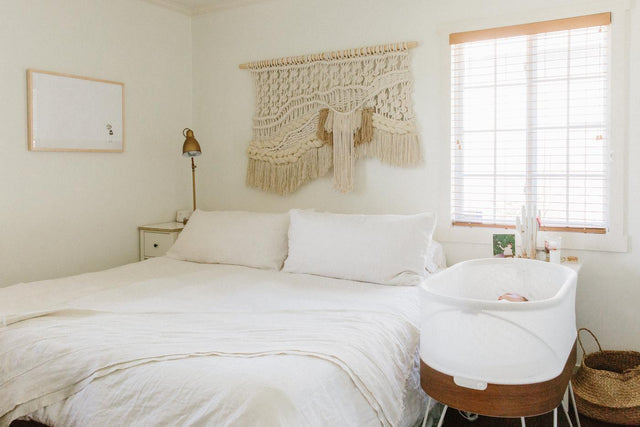Your Guide to Peaceful Room-Sharing With Baby

When you welcome a new baby, you also welcome a new roommate! To help keep babies safe during sleep, the American Academy of Pediatrics recommends room-sharing (not bed-sharing!) for at least the first 6 months. This not only reduces the risk of SIDS, it also makes late-night soothing easier.
But let’s be real: Even though room sharing is safe and smart, it’s not always seamless. Babies and grown-ups tend to have very different sleep styles! If you're feeling a little cramped or out of sync, we’ve got you. Here are some tried-and-true tips to make room sharing a whole lot smoother—for you and your sweet baby.
Pick the right bassinet.
Even though the AAP recommends room-sharing, they’re clear that bed-sharing is not safe. So your first order of business is to create a separate sleep space for your baby. As you begin your hunt for the best bassinet, there are a few boxes you may want to check, including:
- A compact footprint that fits in your room—ideally near your bed
- A sleek design that’s in sync with the rest of your bedroom décor
- Safety features, such as a firm mattress, breathable mesh sides
- Smart features that help both you and your baby sleep longer!
SNOO Smart Sleeper ticks off all of these! In addition to its modern aesthetic, it brings advanced safety features. In fact it’s the only bassinet that secures babies on their backs, which is why it’s FDA De Novo Authorized (see important safety information). Plus, it automatically responds to a baby’s cries with a soothing mix of white noise and motion that calms fussing (often in under a minute) to help babies fall asleep and stay asleep!
Keep the room cool.
Overheating can increase the risk of SIDS, so it’s important to keep your baby’s sleep space comfy—not toasty. Aim to keep your bedroom between 68 and 72 degrees Fahrenheit (20–22°C). Pro tip: A simple room thermometer takes the guesswork out of finding the perfect temp!
Block the light.
Babies love dark rooms—it reminds them of the cozy womb and helps trigger melatonin, the sleepy-time hormone. Hang blackout curtains or use light-blocking shades to help your baby sleep better and longer. Bonus: You might just catch some extra ZZZs, too! Learn more about why darkness is your sleepytime friend.
Add a gentle nightlight.
When you need to tend to your baby in the wee hours or make your way to your own bed after your little one is down, don’t flip on the overhead light! A soft, amber-hued nightlight gives you just enough glow for feedings and diaper changes—without waking your little one (or your partner!) all the way up. A tap-to-turn-on nightlight like SNOObie makes it extra easy to add the exactly-right amount of light. Plus, it comes in a rainbow of hues, including sleep-friendly orange and red.
Use white noise...all night long.
White noise isn’t just soothing—it’s science-backed! Dr. Harvey Karp, author of The Happiest Baby on the Block, includes white noise as one of his proven 5 S’s for calming babies. Continuous white noise mimics the womb and helps block out household sounds (like a flushing toilet or creaky floorboard). And for Mom or Dad, it can help mask the sounds of grunts, snorts, and other no-biggie baby sleep sounds. Pro tip: Avoid wave or nature sounds, which aren’t as effective. You want a steady, low shushing sound.
Keep essentials within arm’s reach.
Less fumbling = less fussing. Middle-of-the-night diaper blowout? Midnight hunger pangs? Be ready for anything! Stock a small bedside basket with:
- Diapers and wipes
- Burp cloths
- Extra swaddle or sleep sack
- A snack and water for yourself
- Pumping supplies
Carve out a cozy sleep zone.
No nursery? No problem. Even in a small room, you can create a designated space for your baby’s bed. Try:
- Rearranging furniture to clear space near your bed
- Using a mini crib or compact bassinet
- Hanging a lightweight curtain or using a partition to "zone off" baby’s nook
Take care of your sleep, too.
Room sharing means you hear everything your baby does—every snort, squeak, and wiggle. It’s normal! But if one parent needs uninterrupted sleep (like a partner who’s headed back to work), it’s okay to take shifts, wear earplugs, or rotate nights “off duty.” Remember: A well-rested parent is a more patient, joyful parent.
Plan ahead for the transition.
For better or worse, room sharing doesn’t last forever! There’s no rush, but around 6 months, you might feel ready to transition your baby to their own room. To make it easier:
- Start with daytime naps in the nursery
- Move the bassinet a few feet farther from your bed each week
- Keep white noise and bedtime routines consistent
- If using SNOO, unsnap your SNOO Sack at the shoulders to free Baby’s arms and try Weaning Mode*
Learn when (and how) to move your baby to their own room!
The Bottom Line
Room sharing is a wonderful way to bond with your baby and keep them safe during sleep—but it works best with a little thoughtful setup. With the right tools, soothing routines, and a dash of flexibility, your shared space can be a peaceful haven for the whole family.
More Baby Sleep Support:
- A Sample Sleep Schedule for Baby’s First Year
- What to Do When Your Baby Won’t Sleep Unless Held
- What Are Wake Windows?
- An Age-by-Age Guide to Your Baby’s Naps
* Some Happiest Baby App features require a Premium subscription